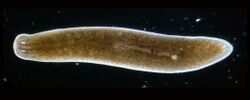Biology:Planaria
| Planaria | |
|---|---|

| |
| Planaria torva | |
| Scientific classification | |
| Domain: | Eukaryota |
| Kingdom: | Animalia |
| Phylum: | Platyhelminthes |
| Order: | Tricladida |
| Family: | Planariidae |
| Genus: | Planaria OF Müller, 1776 |
Planaria is a genus of planarians in the family Planariidae. Due to its excellent ability to regenerate, species of Planaria has also been used as model organisms in regeneration studies.[1] When an individual is cut into pieces, each piece has the ability to regenerate into a fully formed individual.[2]
Various species of Planaria have been widely used as model invertebrate organisms in pharmacological research, in particular in the studies of the drugs of abuse.[3] They were also proposed as models in toxicological research.[4]
Description
Currently the genus Planaria is defined as freshwater triclads with oviducts that unite to form a common oviduct without embracing the bursa copulatrix and with an adenodactyl present in the male atrium. The testes occur along the whole body.[5]
Planaria originally have habitats in dark, murky water which results in such sensitivity (Paskin et al., 2014). They are also sensitive to other stimuli such as chemical gradients, vibration, magnetic and electric fields (Deochand et al., 2018). Their central nervous system includes the anterior (head, brain and eyes) and middle (abdominal trunk and pharynx) (Deochand et al., 2018).
Diet
The food of Planaria species includes freshwater gastropods, tubificid worms, and freshwater arthropods, such as isopods of the genus Asellus and chironomid larvae.[6] In the United Kingdom, P. torva is a successful predator of the invasive New Zealand mud snail (Potamopyrgus jenkinsi).[7]
Species
The following species are recognised in the genus Planaria:
- Planaria adhaerens Korotneff, 1909
- Planaria albocingata Korotneff, 1912
- Planaria barroisi Whitehouse, 1914
- Planaria bicingulata Korotneff, 1912
- Planaria chulunginensis Sabussow, 1903
- Planaria cincinata Korotneff, 1912
- Planaria cinerea Stimpson, 1857
- Planaria dagarensis Sabussow, 1903
- Planaria debilis Korotneff, 1912
- Planaria delineata Korotneff, 1912
- Planaria dybouskyi Sabussow, 1903
- Planaria flava Delle Chiaje, 1822
- Planaria fontana Schrank, 1803
- Planaria fuliginosa Leidy, 1851
- Planaria fuliginosus Leidy, 1851
- Planaria fulvifrons Grube, 1872
- Planaria fuscomaculata Korotneff, 1912
- Planaria gigas Leuckart, 1828
- Planaria grubii Sabussow, 1903
- Planaria ignorata Raspail, 1902
- Planaria incerta Korotneff, 1912
- Planaria kempi Whitehouse, 1913
- Planaria lemani (du Plessis, 1874) Graff, 1876
- Planaria lucta Korotneff, 1912
- Planaria luteola Delle Chiaje, 1822
- Planaria macrocephala Fries, 1879
- Planaria maculata Dalyell, 1853
- Planaria marmorosa Müller, 1776
- Planaria melanocerca Korotneff, 1912
- Planaria melanopunctata Korotneff, 1912
- Planaria melanotorquis Korotneff, 1912
- Planaria nesidensis Delle Chiaje, 1822
- Planaria onegensis Sabussow, 1903
- Planaria punctatum Carus, 1863
- Planaria rosea Müller OF, 1773
- Planaria rothii Braun, 1884
- Planaria sabussowi Korotneff, 1912
- Planaria savignyi Leuckart, 1828
- Planaria semifasciata Korotneff, 1912
- Planaria simplex Woodworth, 1896
- Planaria sinensis Stimpson, 1857
- Planaria subflava Korotneff, 1912
- Planaria torva (Müller OF, 1773)
- Planaria tremellaris Grube, 1840
- Planaria unionicola Woodworth, 1897
- Planaria verrucosa Delle Chiaje, 1829
- Planaria wytegrensis Sabussow, 1907
- Planaria zeylanica Kelaart, 1858
References
- ↑ "Model systems for regeneration: planarians". doi:10.1242/dev.167684. https://journals.biologists.com/dev/article/146/17/dev167684/222983/Model-systems-for-regeneration-planarians.
- ↑ "Unravelling How Planaria Regenerate". Sedeer el-Showk. http://www.nature.com/scitable/blog/accumulating-glitches/unravelling_regeneration_in_planaria.
- ↑ Raffa, Robert B. (2008-12-03) (in en). Planaria: A Model for Drug Action and Abuse. CRC Press. doi:10.1201/9781498713597. ISBN 978-0-429-08997-8. https://www.taylorfrancis.com/books/mono/10.1201/9781498713597/planaria-model-drug-action-abuse-robert-raffa.
- ↑ Shah, Syed Ibrahim; Williams, Adrian C.; Lau, Wing Man; Khutoryanskiy, Vitaliy V. (2020-12-01). "Planarian toxicity fluorescent assay: A rapid and cheap pre-screening tool for potential skin irritants" (in en). Toxicology in Vitro 69: 105004. doi:10.1016/j.tiv.2020.105004. ISSN 0887-2333. PMID 33010358. https://centaur.reading.ac.uk/93218/1/13Oct2020Planaria%20revised%20final%20accepted.pdf.
- ↑ Ball, Ian R.; Reynoldson, T. B.; Warwick, T. (2009). "The taxonomy, habitat and distribution of the freshwater triclad Planaria torva (Platyhelminthes: Turbellaria) in Britain". Journal of Zoology 157 (1): 99–123. doi:10.1111/j.1469-7998.1969.tb01691.x. ISSN 0952-8369.
- ↑ Reynoldson, T. B.; Sefton, A. D. (1976). "The food of Planaria torva (Müller) (Turbellaria-Tricladida), a laboratory and field study". Freshwater Biology 6 (4): 383–393. doi:10.1111/j.1365-2427.1976.tb01623.x. ISSN 0046-5070.
- ↑ Reynoldson, T. B.; Piearce, Bronwen (1979). "Predation on snails by three species of triclad and its bearing on the distribution of Planaria torva in Britain". Journal of Zoology 189 (4): 459–484. doi:10.1111/j.1469-7998.1979.tb03974.x. ISSN 0952-8369.
- Deochand, N., Costello, M. S., & Deochand, M. E. (2018). Behavioral Research with Planaria. Perspectives on behavior science, 41(2), 447–464. https://doi.org/10.1007/s40614-018-00176-w
Wikidata ☰ {{{from}}} entry
 |

